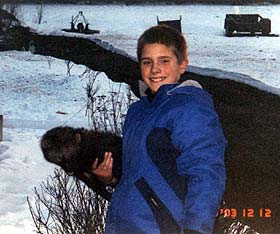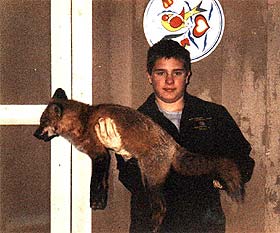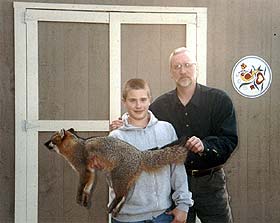|

Home
> Features
> You are here: The Trapping Judge, Part 1
The Trapping Judge, Part 1
By Mel Liston*
|

Ethan's first fisher in 2003.
|
John J. Yazinski was born in northeastern Pennsylvania, the youngest of
four brothers. He would always have plenty of clothes to wear as the hand-me-downs were the rule
versus the exception. Mom had her hands full at
home while Dad did all he could to afford the basic needs of the family.
There was always plenty of food on the table to keep the boys growing,
and the Doctor came to the house when someone got sick, but keeping up
with the Joneses was a race they never entered. Both parents worked very
hard yet they never lost sight of their overriding goal, which was to
provide a loving and caring environment for their boys to grow up in.
John was always called Jackie when growing up until sometime in High
School when Jack became increasingly more common. The sixties and early
seventies was a turbulent era for many youngsters, as there was much
that could go wrong. The brothers were encouraged to participate in school sports and excel in
their studies, both of which Jackie did very
well.
Dad was determined that his boys should all be college educated and one
way he hoped to insure their future in academia was to encourage a
passion for reading. Each son was required to read books and report to
Dad on the content and meaning. To fully engage his student sons, each
was allowed to pick his subject matter. The expense of a growing library
was always affordable in a family that valued knowledge as food for the
mind and brought it into the home along with the groceries.
The rural area in which Jackie grew up offered considerable opportunity for participation in the outdoor woodsy activities
which
were widely practiced and enjoyed back then by a significant portion of
the community. Nearly everyone was a hunter, trapper, or fisherman.
Many of the High School boys had their own rifles and shotguns that were
regularly brought to school in the trunk of an automobile or behind the
seat of a truck. It was important to save time when heading for the
woods to go hunting immediately after the last class of the day. It was acceptable to ask and receive permission to bring a firearm into
the
industrial arts building to refinish the stock or re-blue the gunmetal.
Those students who were on the High School shooting team were allowed to
store their target rifles in the closet of their respective home room
classes. Kids skipped school to go hunting, and the first day of deer
season was always an official school holiday, as few would show up
anyway. It seemed that the whole world was on hold while the majority of
the male population was gone hunting.
|

Ethan's first fox in 2003
|
Jackie did so want to experience and participate in the outdoor rural
heritage and its right of passage. Yet Dad, in spite of all his superb
and enduring qualities was not the outdoor woodsy type, nor did an
appropriate uncle or other mentor materialize. Athletic sports and
academic study would have to suffice while the bulk of Jackie's real
interest in the great outdoors remained repressed just below the
surface. The passion for reading fully developed with the obsessive
desire to learn all about adventurers like Jim Bridger and Kit Carson,
or the Rocky Mountain Fur Trade, Indians, Hunting, Trapping, and Woods
Lore. At the age of ten, when Jackie went along with mom or dad to get
the
groceries, they often came home with an outdoor fishing, hunting, or
trapping magazine and extra flashlight batteries. Jackie would tent up
in bed at night and read about his favorite outdoor subjects before
drifting away into a world of hunting for food or sport and trapping fur
in the mystical back country. Visions of a remote trappers cabin,
dogsleds in the Yukon, and Rendezvous at the Green River Valley in
Wyoming were final thoughts as the book or magazine slowly settled where
it would be found in the morning. The genetic predisposition to be a hunter/gatherer was strong and growing.
The desire to be connected to the outdoors grew, as Jackie became
Jack to his circle of friends who were all into hunting and fishing.
Just as soon as Jack was old enough to purchase a hunting license in
Pennsylvania, he bought his first deer rifle with the money he earned
and saved from a newspaper route. Hunting with his buddies instilled a
passion for the sport with as much time as available devoted to the
outdoor endeavors. In the back of Jack's mind was etched the awareness
of yet another type of hunting even more specialized and reserved for a smaller community of woodsmen. Jack yearned to experience the challenge
of a trap line. Jack wondered about wildcats, fisher, mink, otter,
beaver, fox, and coyote. What would it take to harvest these animals,
and could he learn to do it? What would a collection of tanned fur look like
hanging in the bedroom?
One day while fishing a small stream, Jack happened upon a mink
trapper tending his line. The young man was so full of questions that
he engaged the old trapper like a man in the desert who had just found
the water hole that shall save his life. No old trapper can resist a
youth who thirsts for the mysteries held within his experience. A
thousand questions later the solitary trapper walked up the bank and was
gone on about his business. The vision of the old trapper would remain
forever in the minds eye of a young man who would bide his time for the day when he too might cut such a path.
|

Father and son with their first grey fox of 2004
|
Soon Jack would be off to college where he would occasionally get a
chance to hunt or tag along on another's trap line. Immediately after
college, adult life quickly set in. By this I mean employment in
northeastern Pennsylvania, marriage, plus all the associated
obligations, which makes the requirements of a seven-day per week trap
line difficult or impossible. In spite of the obstacles, the ways
and means were carved out, so that by 1984 the stage was setting for
Jack's first farm country trap line. Equipment was purchased and readied,
landowner permission for a limited first season was lined up, and all
was ready in the summer for the approaching fall season. However, an opportunity presented itself for another life goal, and the
trap line
was
put on hold once again while the next phase of Jack's life and career began to take
shape and unfold for the young married couple. It was back to the books
again, this time for a legal degree. Jack and his wife Nancy moved lock,
stock, and boxed up trapping equipment to New Hampshire so Jack could
attend Franklin Pierce Law Center in Concord. Husband and wife pulled together to make the education possible,
further
balancing
family needs against professional requirements during the tough years
while breaking into the legal profession in the Claremont and Hanover
area. As in most things you have to put your time in. Bottom pay and
extremely long hours working as low man in the legal staff preceded the
time when Jack's experience could justify his own firm in 1990. Jack and
Nancy now settled into a rural lifestyle provided on the 100-acre country property they named Stones Throw Farm. Ascutney
Mountain looms
across the Connecticut River in Vermont, seemingly a stones-throw away.
Jack began to find a little time for hunting and fishing. In 1992 their
only child was born, a son they named Ethan. Jack put infant Ethan in a
pack frame and hauled him along when canoeing and fishing. As soon as Ethan developed sufficient dexterity he became a fisherman and
shortly
thereafter developed skill with a fly rod. Target practice and firearm
safety were started as soon as Ethan was interested and ready. It was
not long before the son was tagging along with his dad during the
hunting season. Jack and Ethan were great outdoor buddies, bonded just
that much more than many a father and son who do not share such a common
passion.
Jack's repressed desire to be a trapper always lingered just below
the surface, and he had maintained his interest over the years with
occasional trapping magazine subscriptions and trips to the shed to look
at the never utilized traps from 1984 hanging on the wall. Jack would
spend idle moments in the presence of his trap collection visualizing
himself as a trapper. As many caring and responsible parents know, it is
often difficult to justify or rationalize a hobby or interest that does
not contribute to the family financially or involve the family for
quality time together. Jack would continue to bide his time, not really
knowing if his opportunity to trap would ever really materialize.
Click
here to read The Trapping Judge, Part 2
*Mel Liston, from Strafford, New Hampshire is a
freelance writer, Trapper Education Instructor, Director for the New
Hampshire Trappers Association and a member of the National Trappers
Association and the Fur Takers of America.

Home
> Features
> You are here: The Trapping Judge, Part 1

|